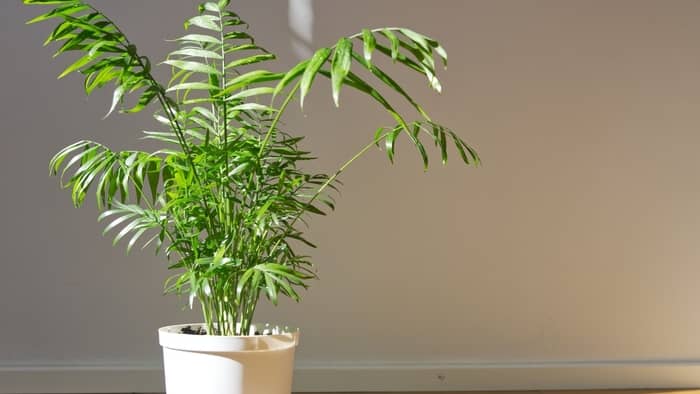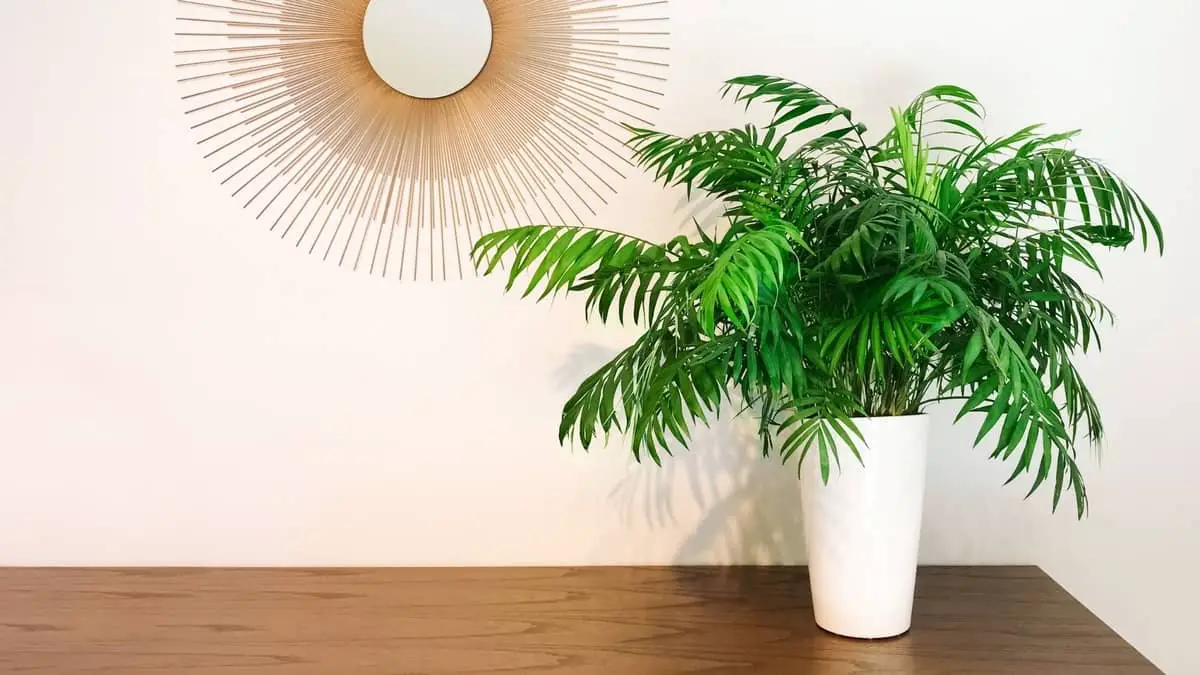Last Updated on September 25, 2022 by Griselda M.
Both Areca and Parlor palms are smallish delicate palms that are popular indoor plants in cooler regions of the world, and outdoor plants in warmer areas. Areca palms can actually refer to a few different species, hence in this case we refer to the Areca houseplant. We will go into this in a bit more detail. Let us compare the Parlor Palm vs Areca Palm.
A Quick Definition Of The Parlor Palm and The Areca Palm
Popular names are really confusing things as they can often refer to the wrong plants if you get confused. So in this article, we talk about Areca palm as the common indoor plant, Dypsis lutescens. The Parlour Palm we refer to is Chamaedorea elegant. The advantage of a species name is it can only refer to one plant!
The Parlour Palm is originally from Southern Mexica/Guatemala. This palm is one of those things you will probably get given five times in your life! I think when I was a student I received a few each time I moved into a new house as a housewarming gift.
Areca palms are native to Madagascar but have been spread around the world as indoor plants, and have become quite widespread in warmer climates outdoors.
Read more about Does Diesel Kill Weeds – Find Out The Answer About This Myth Or Fact

How To Identify an Areca Palm?
The Areca Palm is a small, to medium-sized palm. In warmer climates, it can grow to about 40 feet tall but generally as a house plant it is much smaller. It is also known as a bamboo palm due to its distinctive yellow bamboo-like stem, and a butterfly palm because it has leaves that fold upwards like a butterfly.
So, if it is a small palm, has a yellow bamboo-like stem, and butterfly-like leaves that fold upwards, chances are it is an Areca palm. Many apps will identify this plant easily as it is a very common plant.
How To Identify a Parlour Palm?
The Parlour Palm is a much smaller palm than the Areca palm, growing to a maximum of about 9 feet tall making it a perfect indoor palm. Unlike the bamboo palm which sends new shoots up from the base, the Parlour palm does not. Typically when I have bought these they consist of about 10-20 small palms all grown from seed in a clump. Over the years, the smaller weaker ones die until one or two palms are dominant in this clump.
The Parlour palm has a dark green stem. A key identifier of this little palm is that it will start flowering when it is just a foot to a foot and a half tall! This really confused me the first time it happened as I was trying to figure out what the weird new leaf was and then it got buds and flowers!! Again, most of the common plant identification apps will help you identify the plant.
Using a Key to Identify Palms
I used to hate using identification keys when I did Botany at University. Luckily they are a bit more interactive now, and if you use one like this you can very quickly identify most of the common palms. Each drop-down menu keys out a specific characteristic, that then narrows down your selection of the candidate’s palms.
Areca Palm vs Parlor Palm
In Victorian times (the 1850s to 1900s) the Parlor Palm we a fashionable palm because it could survive the winters in unheated houses and solariums/greenhouses of industrial revolution era England. The parlor refers to what we would probably call a living room now. Hence this was the palm you grew in your living room.
The Parlor palm can tolerate quite low temperatures and humidity and is a pretty tough palm. Areca palms are more adapted to our modern world where we have better heat and humidity control. I used to have both of these palms and kept them in my laundry room in winter – the laundry room has a transparent roof that lets nice light in, and I would run my tumble dryer on colder days to warm the room and put some humidity in the air.
The palms thrived in this environment. I have since moved to a system of having only indigenous ornamentals as much as I can do this, so my palms have moved to friends’ houses where they are loved and cherished.
Areca palms tend to form clumps with time and are a more aggressive species. They can get quite big and need a bit more warmth in winter than a Parlor palm. You will need to maintain higher winter humidity for an Areca than a Parlor palm.
However, for both, a bit of humidity maintenance will not hurt. Modern humidifiers spray a small jet of ionized water droplets into the air, hence you can place a humidifier unit such as the one in the ling just below under the palms and this will help to keep them happy and reduce the risk of winter outbreaks of diseases such as scale and mealy bugs etc.
I would suggest that for both Areca and Parlor palms if you cannot give them a humid environment, you at least put a humidifier in the room in winter, as they do seem to hate low humidity.
What Is Behind The Names Of Areca vs Parlor Palm?
As we have mentioned, the Parlor palm derived its name during the Victorian era when it was a popular palm to keep in the Parlor (a bit like a living room) due to its relatively cold and low light tolerance capability.
The Areca palm from what I can gather is just a case of people collecting a name that is used to describe a lot of palm trees native to the East and using that name to describe a palm from Madagascar. This actually confuses, as the real Areca palms are quite big trees not suited to indoor growth at all. Hence it also has other names such as butterfly palm, bamboo palm, and many others.
This is why species names help a bit in terms of actually referring to a specific plant, rather than some word borrowed from one culture and inaccurately transplanted into another.
Parlour Palm vs Areca Palm – Which One Is Better?

Both palms are beautiful! I would suggest that if you like them, get one of each and see which works best in your area. For me, I would choose an Areca because it will with time produce offsets and I can then divide the clumps and get more plants. The Parlor palm tends to arrive from the nursery with quite a few stems derived from multiple seeds planted and gradually with time these will die, and you will end up with one or two dominant plants.
The Areca palm in my experience grows much bigger than the parlor palm! However, you can trim the longer Areca palm stalks off, and new smaller palms will shoot from the base. You cannot do this with a Parlor palm. Hence, make sure that you have enough headroom for a palm to reach 6-7 feet tall with a parlor palm.
Conclusion On Parlor Palm vs Areca Palm
For a colder house, the Parlor Palm is probably the best choice. If you can maintain temperatures in the 60-80°F range, and humidity in the 40-50% range in winter, then consider an Areca as well. I strongly suggest as I do with many either or plant choices that you just choose both and see which one works in your environment. This is generally the lowest risk option.
Read more about How Deep Are Palm Tree Roots?
Frequently Asked Question
Is Parlor Palm Good for the Environment?
Parlor palms help to clean the air in your home. The Areca palm is, however, a well-studied plant, that NASA researchers have shown can remove complex household pollutants such as solvent residues emanating from paint and plastics. In this regard, published data favors the Areca over the Parlor as an air purifying plant.
Is it necessary to remove palm leaves?
No. In nature, they just fall off the palms. But your plant will probably be more aesthetically pleasing if you trim dead leaves off it.
Branko is the world‘s most enthusiastic gardener! He is always on the hunt for the perfect flower, bush or tree to add to his ever–growing garden. He is known for his love of all things green, and his passion for nurturing the plants he grows is unmatched. He loves to get his hands dirty and can often be found humbly tending to his garden at all hours of the day. Branko is the go–to guy when it comes to gardening advice – he is always happy to share his knowledge and wisdom with anyone who will listen. He also loves to play pranks on unsuspecting visitors, so beware if you enter his garden!



